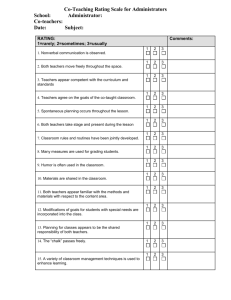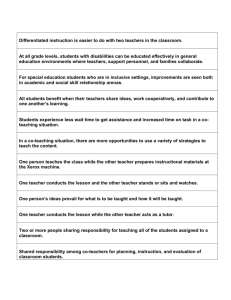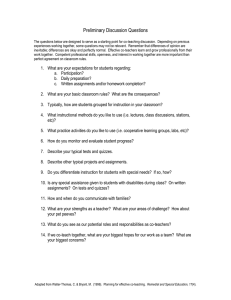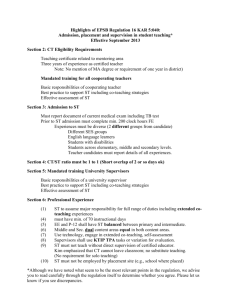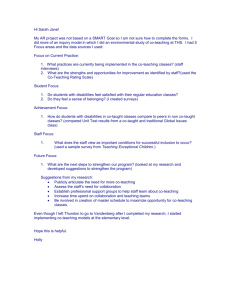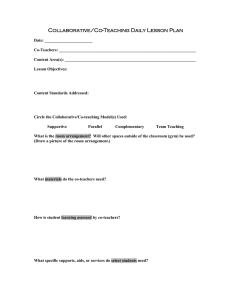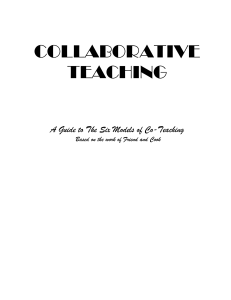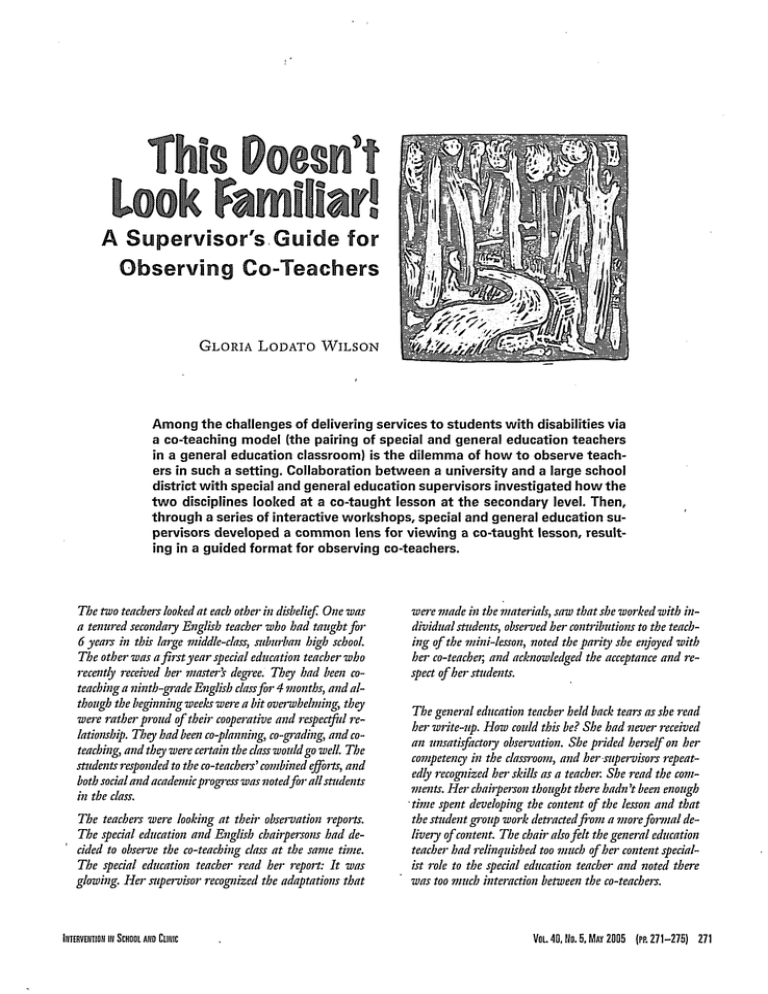
loo
ml' l
A Supervisor's Guide for
Observing Co-Teachers
ilarar
I
GLORIA LODATO WILSON
Among the challenges of delivering services to students with disabilities via
a co-teaching model (the pairing of special and general education teachers
in a general education classroom) is the dilemma of how to observe teachers in such a setting. Collaboration between a university and a large school
district with special and general education supervisors investigated how the
two disciplines looked at a co-taught lesson at the secondary level. Then,
through a series of interactive workshops, special and general education supervisors developed a common lens for viewing a co-taught lesson, resulting in a guided format for observing co-teachers.
The two teachers looked at each other in disbelief One was
a tenured secondary English teacher who had taightfor
6 years in this large miiiddle-class, sulbur^ban high schooL
The otherwas afirstyearspecial eduication teacherwho
recenitly received her 7naster7 degree. They had been coteachinga ninth-gradeEnglish classfor 4 mtonths, and although the beginningweeks were a bit overwhelming, they
were ratherprou0d of their cooperative and respectful relationship. They had been co-planning, co-gradinzg, andcoteachinig, and they were certain the class wouldgo well. The
students responded to the co-teachers'combined efforts, and
both socialand academicprogresswas notedforallstudents
in the class.
The teachers were looking at their observation reports.
The special education and English chai7persons had decided to observe the co-teaching class at the same timne.
The special education teacher read her report: It was
glowving. Her suipervisor recognized the adaptationsthat
ltiTERVEliTIBIl
IIISCHOOL
AIID
CLIUIC
were mtade in the 7materials,saw thatshe worked with individualsttudents, observed her contributionsto the teaching of the miini-lesson, noted the parity she enjoyed with
her co-teacher, and acknowledged the acceptance and respect of her stutdents.
The general eduication teacher held back tears as she read
her write-up. How could this be? She had never received
an unsatisfactoyy observation. She prided herself on her
competency in the classroom, and her supervisors repeatedly recognized her skills as a teacher: She read the com7mients. Her chairpersonthoutght there hadn't been enouigh
time spent developing the content of the lesson and that
the stuident grouipwork detractedfirom a moreformal delivery of content. The chair alsofelt the general education
teacher had r7elinquished too much of her content specialist role to the special education teacher and noted there
was too much interactionbetween the co-teachers.
VOL.
40, No. 5.MAY
2005 (pp.
271-275) 271
The practice of delivering special education services to
students through co-teaching-the pairing of general and
special education teachers in general education classesis becoming increasingly popular in the United States. As
this practice increases, so does our understanding of its
complexities. Among the issues developing is the dilemma
of supervision and observation of co-teachers. Although
there is an ever-expanding literature base on the practice
of co-teaching (e.g., Murawski & Swanson, 2001) and the
beginnings of a body of outcome or efficacy research (e.g.,
Gable, Mostert, & Tonelon, 2004), there are virtually no
guidelines or research studies addressing supervision of
collaborative efforts from either the special or general education vantage point.
Co-teachers have increasing opportunities for collaborative training that usually investigates the relationships
and roles of each teacher in creating access to the general
curriculum as well as various models of co-teaching, instructional methods, and material adaptations. Historically, though, general education supervisors have had
little guidance in observing special education teachers
(Breton & Donaldson, 1991; Schutz & Zeph, 1990-1991),
and both general and special education supervisors may
not have access to specific training in the intricacies of
observing a co-taught lesson. As the vignette illustrates,
depending on the orientation of the supervisor, the same
co-taught lesson could be viewed in diametrically opposing ways. The vignette exemplifies the importance of
raising administrator awareness to the dynamics of a cotaught lesson.
A recent survey (Wilson & Pace, 2002) on co-taught
inclusion programs revealed that 84% of directors of special education rated their co-teaching inclusion programs
as sutperiorto very good, which raises significant questions:
1. How do special education administrators actually
know their programs are superior or very good?
2. Do special and general education administrators use
similar criteria when evaluating co-taught lessons?
3. How might special and general education administrators collaborate and generate shared evaluation
criteria when rating their co-taught inclusion
programs?
This article describes a process used to initially investigate these important questions and to develop a reflective observation guide for supervisors of both special and
general educators in co-taught classes.
The Need for a Co-Teaching
Observation Tool
A collaborative project among a local university and
school district, district central and building administration, and special and general education supervisors began
in the fall of the school year during which the district's
CINIIC
AIIO
IIISCHOOL
272 IIITERVEIHIOII
gradual emersion into co-taught classes had reached its
critical mass. Three high schools, 2 middle schools, 38 special education teachers, 65 general education teachers,
and 93 classes were involved in the co-taught collaborative program. As the program grew, conversations and
questions about supervision and observation began to
emerge. Specifically, teachers began to express puzzlement over how they were being observed. Both special
and general education teachers wanted guidance about
how and by whom they were to be observed. Questions
began circling about various aspects of supervision. For
example, were the co-teachers to be treated as one and
receive a single observation report? Could the special education supervisor comment on the general educator's
performance, even if the focus of the observation was the
special educator? Should the general and special education supervisors observe the same lesson? Should they
write one observation? Are there different criteria of performance for the general and special education teachers?
As these and other questions were discussed, one foundational or fundamental question emerged: What criteria
should be used to judge teacher performance in a cotaught class or program?
To address this critical question, the assistant superintendent of curriculum planned a series of monthly meetings comprised of a consultant from the local university
who had been working with the co-teachers for 3 years,
the director of special education and pupil personnel services, assistant principals from two middle schools and
three high schools, and department chairs from each
school. A total of 23 supervisory personnel were involved
in the meetings. The monthly meetings were structured
by the consultant to begin a "cycle of inquiry" (Silva &
Dana, 2001, p. 316) so all stakeholders could begin to collaboratively address co-teaching observations and examine
cooperative teaching teams (Salend, Gordon, & LopezVona, 2002).
Establishing Criteria for Judging a
Co-taught Class or Progam
The year-long process involved the facilitation of open and
frank discussions concerning the program and the unique
dimensions of a co-taught program. The road to the development and use of the co-teaching observation tool
can be broken into four phases. Each phase addressed an
essential question:
Phase 1: What makes a good lesson?
Phase 2: Does the evaluation of a co-taught lesson
require a unique perspective?
Phase 3: What are the essential components needed in
an observation tool for co-taught lessons?
Phase 4: How useful is the observation tool that was
developed?
Phase 1: What Makes a Good Lesson?
We first asked the group to collaborate in generating an
answer to the question, What makes a good lesson? In
other words, when observing a teacher, what do you look
for during a lesson? The following is the composite of
answers generated:
* Lessons are student-centered
e Recognition of diverse learning styles of students
* Questions tap high-order thinking
* Engagement of students and evidence that students
are on task
e Use of materials that are useful and available
* Attention to motivation
* Awareness of transitions
e Aims that are open-ended
* Summation at the middle and end of the lesson
* Activities that apply the information
• Connections made to students' experiences
* Positive student-teacher relationships and
interactions
* Appropriate use of technology
e Adherence to state standards
* Reinforcement of previously learned and new
material
Stakeholders were in consensus that these were necessary
for a good lesson and that the list represented what both
special and general education supervisors generally
looked for when observing a teacher.
As a second part of Phase 1, the group generated an
answer to the question, What is needed to make a good cotaught lesson? All agreed that everything on the list was
important. Supervisors felt that one additional attribute
had to be added: positive teacher-teacher relationships.
Phase 2: Does the Evaluation of a Co-Taught
Class Require a Unique Perspective?
During Phase 2, stakeholders observed two videotaped
co-taught lessons. One was a 10th-grade biology lesson
co-taught by a veteran special education teacher who was
also certified in biology and a first-year general education
biology teacher. The second lesson was a ninth-grade
English class taught by a special educator and general educator who had been co-teaching for 4 years.
The group viewed the videotapes, and the supervisors
observed and commented. The supervisors discussed the
roles of the four teachers, the strategies used to assist learning, and the need to know whether or not the students
were learning the material. What became increasingly
obvious was that the focus of the observations shifted
from the presentation and content concerns of observing
individually taught classes. Three themes emerged that
highlighted the subtle and blatant differences between
singly-taught and co-taught classes:
Roles of the teachers
* Instructional strategies
o Assessment processes
e
Phase 3: What Are the Essential Components
Needed in an Observation Tool for
Co-Taught Lessons?
The supervisors thought it would be helpful to develop an
instrument to guide their observations. The co-teaching
observation guide (see Figure 1) was developed to assist
the group in reaching consensus on the essential components in observing a co-taught lesson. Because it is widely
accepted that co-teaching is a process and that co-teachers
How can I determine if a co-taught collaborative
inclusion class is being taught as effectively
as possible?
Questions I should be asking myself as I observe ...
1.The Basics: Meaningful Roles for Each Teacher
1. Can the role of each teacher be defined at any given
point inthe lesson?
2. Is each role meaningful? Does each role enhance the
learning process?
3. Do the teachers vary their roles during the course of
the lesson?
4. Is each teacher well suited to the role(s) he or she
is assuming?
5. Are both teachers comfortable with process AND
content?
6. Is the special education teacher working with all students?
11.Strategies to Promote Success for ALL Students
1. What evidence is there that teachers engaged in
co-planning the lesson?
2. Are the teachers focusing on process as well as
content? Are they reinforcing important skills?
3. Are directions clear?
4. What strategies/modifications are being employed
to assist struggling students?
5. What adaptations were made to materials inorder to
help struggling students complete tasks?
6. What strategies are being used to actively engage
students?
7. How are students being grouped? Does it fit the task?
Is it purposeful?
8. What reinforcement strategies are being employed?
111.
Evidence of Success
1. Are struggling students answering/asking questions?
2. Are students engaged in meaningful work throughout
the period?
3. How are teachers assessing the learning of each
student?
4. What evidence is there that all students have been
appropriately challenged?
Figure 1. The co-teaching observation guide.
VOL.
40. NO.
5.MAY
2005
273
continue to develop their skills as they work together
through the years (Gately & Gately, 2001), the instrument
is reflective in nature and based on a series of questions,
grouped into the three following sections addressing the
themes developed by the group discussions:
Theme 1. The Basics: MeanintgfitldRolesforEachTeacher.
The concentration in this first section is on the basic coteacher roles. Although not specifically delineated, the
supervisor is to look at the elemental roles of co-teachers,
such as grazing, tag-team teaching, teaching-on-purpose,
and various roles dependent on types of groupings
(Vaughn, Schumm, & Arguelles, 1997). Questions in this
section lead the observer to target not only content but
process, as well as the relationship each co-teacher has
with all students.
Theme 2. Strategiesto Promote SutccessforAll Stuidents.
The attention to how strategies are incorporated into a
lesson characterizes the second section of the guide. The
supervisors recognized that for co-teaching to be successful, evidence of co-planning needed to be easily seen
through the strategies and modifications integrated
throughout the lesson. In addition, we agreed with Page
(2003) who stated, "An overarching goal of .. . supervision ... is to help teachers develop practices that increase
the achievement of all students" (p. 161).
Themne 3. Evidence ofSuiccess. Undeniably the most important section concentrates on the actual success of the
students enrolled in the co-taught classes. The purpose
of a co-taught class is to give students the opportunity to
succeed in an inclusive setting; therefore, a continuous
and conscious effort to assess student achievement is essential. Reflective questions make it clear that assessment
must be an ongoing and conspicuous part of each lesson.
Phase 4: How Useful Is the Tool?
Discussions concerning the instrument's use ensued with
the supervisors. The group believed that although the
three areas of the guide were critical, only specific questions in each area might actually be used during an observation to avoid overwhelming the supervisor and the
teachers. They stressed the importance of the preobservation conference and the need for a mutual decision made
by the supervisor and the teacher as to what questions in
each area would be used. Similarly, discussions in the
postlesson debriefing would lead to the choice of questions for future observations.
Although the supervisors wanted a streamlined guide,
they also needed clarification of the elements contained
within the questions. For instance, they asked for a delineation of possible teacher roles, types of strategies that
could be used, examples of modifications for materials,
and types of assessments that could be incorporated eas274
IIITERVEJITIOII
III SCHOOL
AID CLiNIc
ily within daily lessons. We are, therefore, working on a
companion guide to the observation guide to clarify the
reflective questions in a very clear and concrete manner.
We have received very positive feedback on the preliminary use of the observation guide. Supervisors felt
more informed and empowered because they developed
the guide over a period of time during which their awareness of the intricacies of co-teaching was expanded. The
supervisors also noted that the guide helped them focus
on essential components of co-teaching when they were
observing and helped structure the writing of their observation reports. In addition, sharing the guide with the
co-teachers in the preobservation meeting fostered a positive and trusting relationship between the supervisors and
the co-teachers because expectations were clearly defined.
Conclusion
The current trend toward teaching students with special
needs in inclusive, co-taught settings necessitated the development of a useful observation guide. The co-teaching
observation guide gives some uniformity and fairness to
the observations of co-teachers, thus avoiding the contradictory messages sent to the teachers, such as those in
our opening vignette. In addition, the guide assists supervisors who typically rate teachers primarily on lesson
procedures and content and who are unfamiliar with both
the co-teaching model and inclusive settings.
We anticipate that our continuing collaborative efforts
to refine the guide for supervisors will also have positive
effects on teaching and the teachers themselves (Ebmeier, 2003). The guide, when shared with teachers, can
indirectly influence actual practices within the classroom
when teachers are not being observed and potentially increase teacher feelings of efficacy (Coladarci & Breton,
1997). In addition, the guide's clarity about the three essential elements (i.e., roles, strategies, assessment) of a cotaught class will guide teachers on what the district values.
Moreover, the guide provides a springboard for ongoing conversations concerning the evolution of coteaching practices for school districts committed to the
success of students in inclusive settings; further, it will assist in efforts to determine how co-teaching effectively
addresses the students' needs. The instrument is considered a work in progress. All of the co-teachers are being
asked for their input, and supervisors are further fieldtesting the usefulness of the questions in guiding their
observations.
We are encouraged by the success of the collaborative
process used to develop the co-teaching observation guide
and by the initial feedback from both supervisors and
teachers, but we realize that we limited ourselves to addressing the fundamental question: What criteria should
be used to judge teacher performance in a co-taught class
or program? There were additional questions posed by
the group that require further investigation: Were the
co-teachers to be treated as "one" and receive a single observation report? Could the special education supervisor
comment on the general educator's performance, even if
the focus of the observation was the special educator?
Should the general education supervisor and the special
education supervisor observe the same lesson? Should
they write one observation? The district involved in this
significant collaboration effort intends to continue discussions to address these important questions.
ABOUT THE AUTHOR
Gloria Lodato Wilson, PhD, is an assistant professor of special education at Hofstra University's School of Education and
Allied Human Services. Her current research interests include
the teaching and supervising of co-taught classes, student competency, and the effects of high-stakes testing on students with
learning disabilities. Address: Gloria Lodato Wilson, Department of Special Education, School of Education and Allied
Human Services, 230 Hagedorn Hall, 119 Hofstra University,
Hempstead, NY 11549-1190; e-mail: gloria.wilson@hofstra.edu
REFERENCES
Breton, W. A., &Donaldson, G. A.(1991). Too little, too late? The supervision of Maine resource room teachers. The Jouirnal of Special
Edutcation, 25, 114-125.
- v
t t
d
r -
I
I
I
. 1, -
I I
I
I -I -
Coladarci, T., & Breton, W. A. (1997). Teacher efficacy, supervision,
and the special education resource-room teacher. Journal of EdulcationalResearch, 90(4), 230-239.
Ebmeier, H. (2003). How supervision influences teacher efficacy and
commitment An investigation of a path model. Journalof Curriculum and Sutperuision, 18(2), 110-141.
Gable, R. A., Mostert, M. P., &Tonelson, S. W. (2004). Assessing professional collaboration in schools: Knowing what works. Preventing
School Failure, 48(3), 4-8.
Gately, S. E., & Gately, E.J. (2001). Understanding coteaching components. Teaching Exceptional Children, 33(4), 40-47.
Murawski, W. W., & Swanson, H. L. (2001). A meta-analysis of coteaching research: Where are the data? Remedial and Special Education, 22(5), 258-267.
Page, M. L. (2003). Race, culture, and the supervisory relationship: A
review of the literature and a call to action.journalof Curriculumand
Sutpervision, 18(2), 161-174.
Salend, S. J., Gordon, J., & Lopez-Vona, K. (2002). Evaluating cooperative teaching teams. Intervention in School and Clinic, 37, 195200.
Schutz, P. N., &Zeph, L. A. (1990-1991, Winter). Evaluation of special education teachers. The RuralEducator, 12(2), 20-23.
Silva, D. Y., &Dana, N. E (2001). Collaborative supervision in the professional development school. Journalof Curric7ulun and SuperZvision,
16, 305-321.
Vaughn, S., Schumm, J. S., & Arguelles, M. E. (1997). The ABCDE's
of co-teaching. Teaching Exceptional Children, 30(2), 4-10.
Wilson, G. L., &Pace, D. (2002). [Project co-teach]. Unpublished raw
data. (Available from Gloria L. Wilson, Dept. of Education, School
of Education and Allied Human Services, 230 Hagedorn Hall, 119
Hofstra University, Hempstead, NY 11549-1190)
__
I
I I
CALL FOR R
$ANUwcREiITr
CAREER -DEVELOPMENT FOR
EXCEPTIONAL INDIVIDUALS
-
El
I
1
CO
t:AQ: :R
::;::0
:: 0l0:
0
Official journal for
the Division on Career Development and Transition - CEC
NODW pulbllishaed
by ]PRO
1D
1__
__--
Articles for CDEI are accepted for review on a continual basis. The editors welcome
articles in the areas of secondary education, transition, and career development of
persons with disabilities and special needs. Articles published in CDEI indude original
quantitative and qualitative research, scholarly reviews, and program descriptions and
evaluations.
Complete author guidelines may be obtained from:
David Test (dwtest@email.unccedu; 704-687-3731),
Bob Algozzine (rfalgozz@email.uncc.edu; 704-687-2912), or
PRO-ED (journals@proedinccom)
(pro-ed
2005 275
VoI. 40. No.5. MAY
COPYRIGHT INFORMATION
TITLE: This Doesn’t Look Familiar! A Supervisor’s Guide for
Observing Co-Teachers
SOURCE: Intervention Sch Clin 40 no5 My 2005
WN: 0512102658003
The magazine publisher is the copyright holder of this article and it
is reproduced with permission. Further reproduction of this article in
violation of the copyright is prohibited. To contact the publisher:
http://www.proedinc.com/
Copyright 1982-2005 The H.W. Wilson Company.
All rights reserved.

